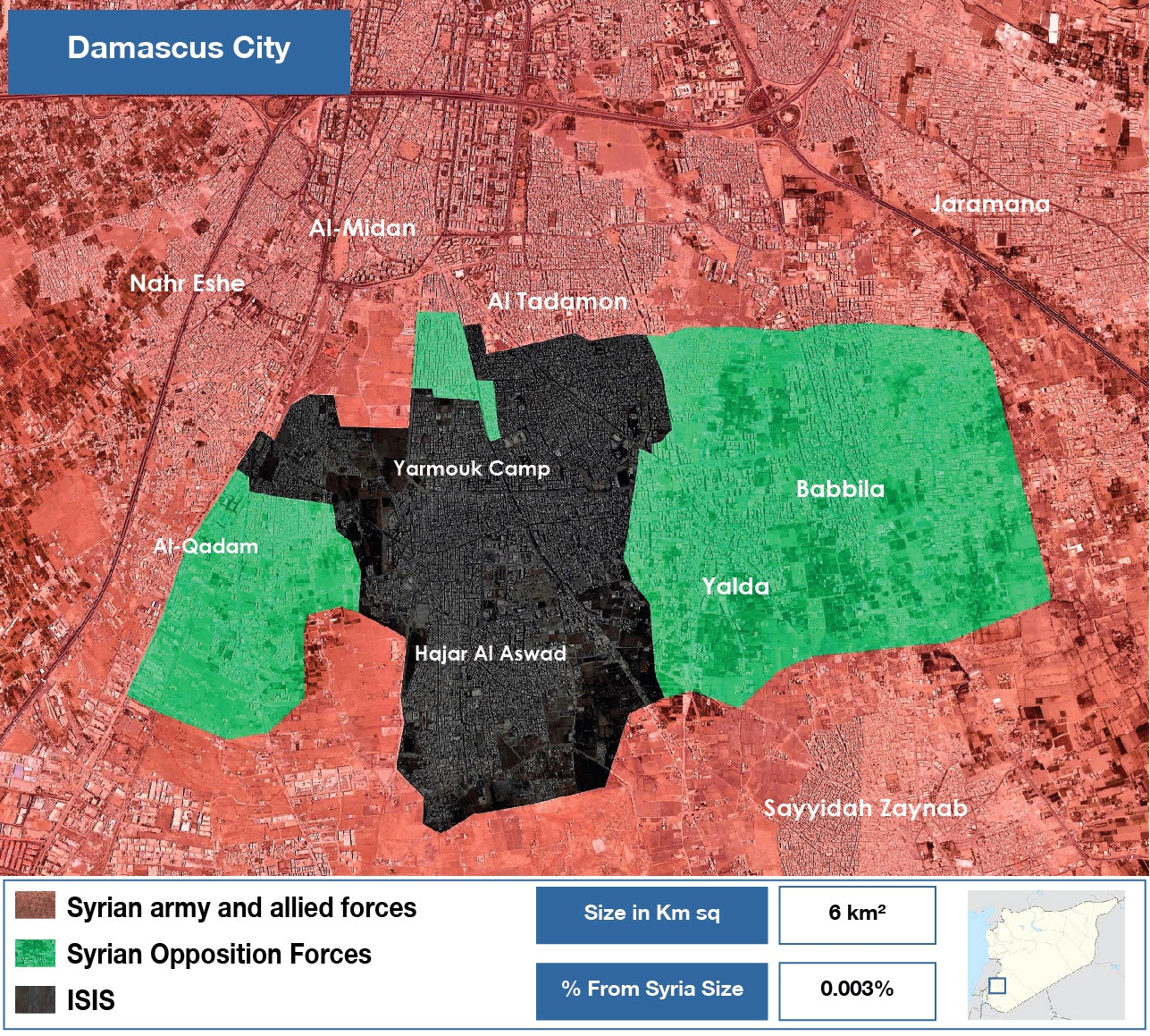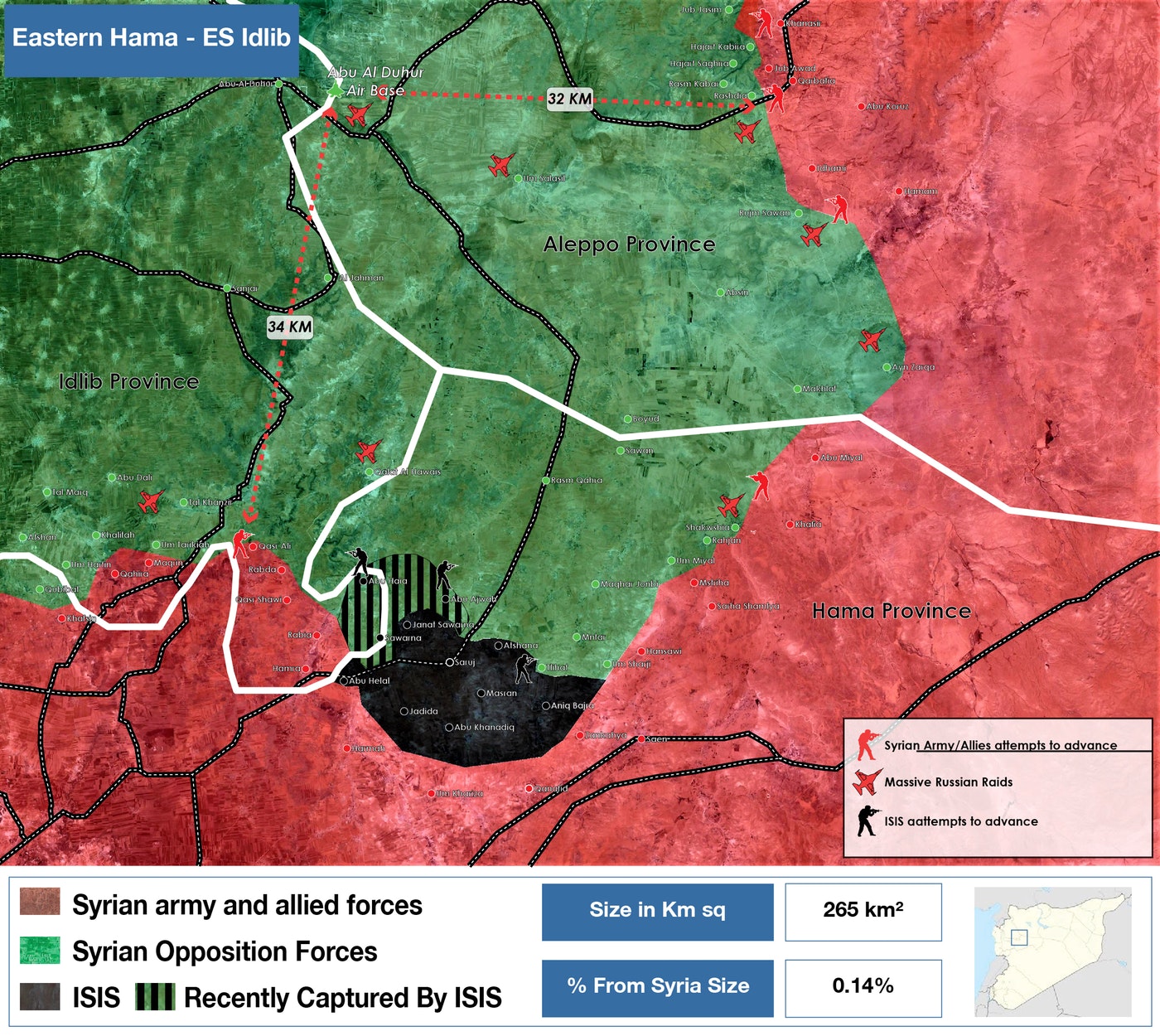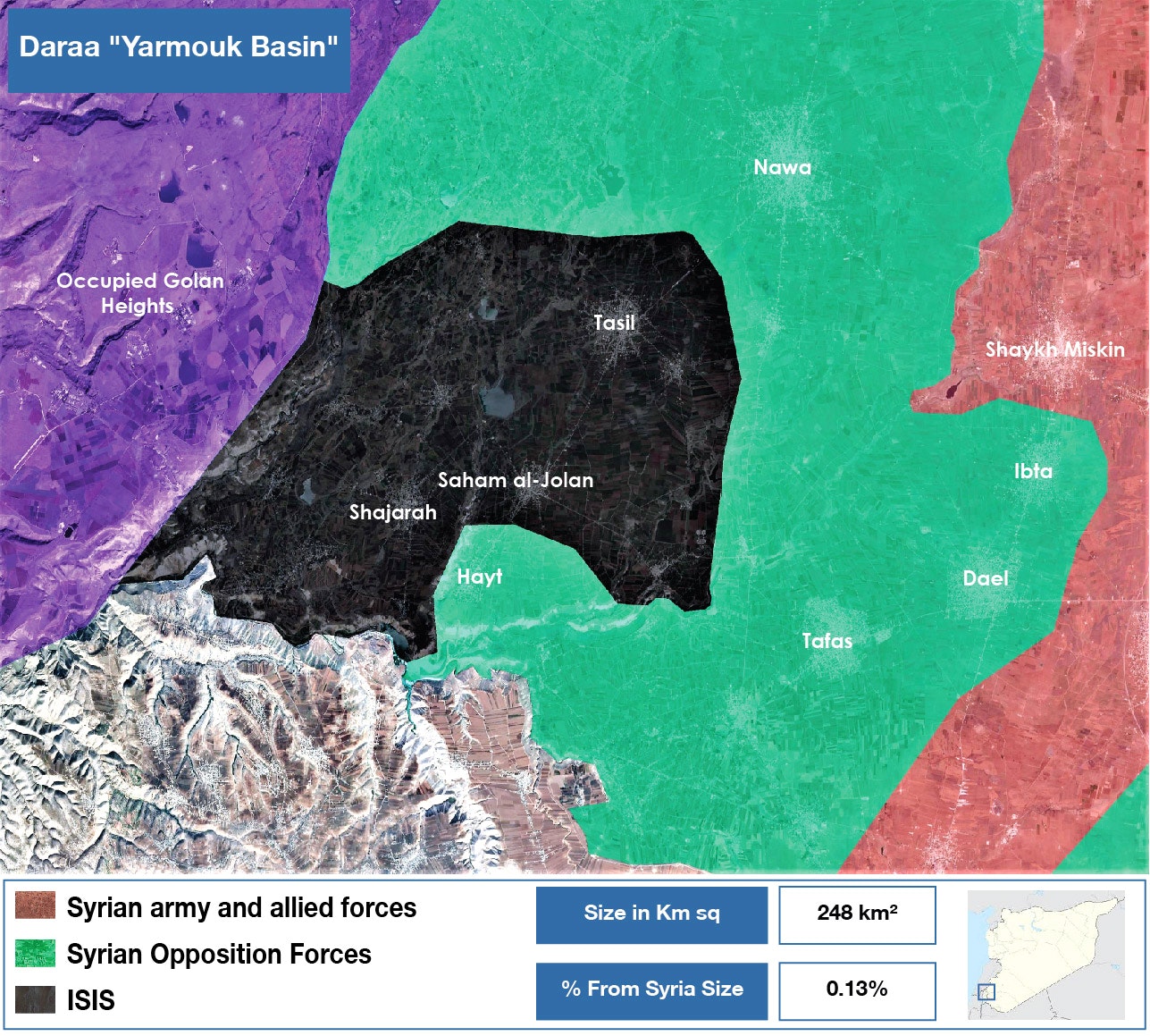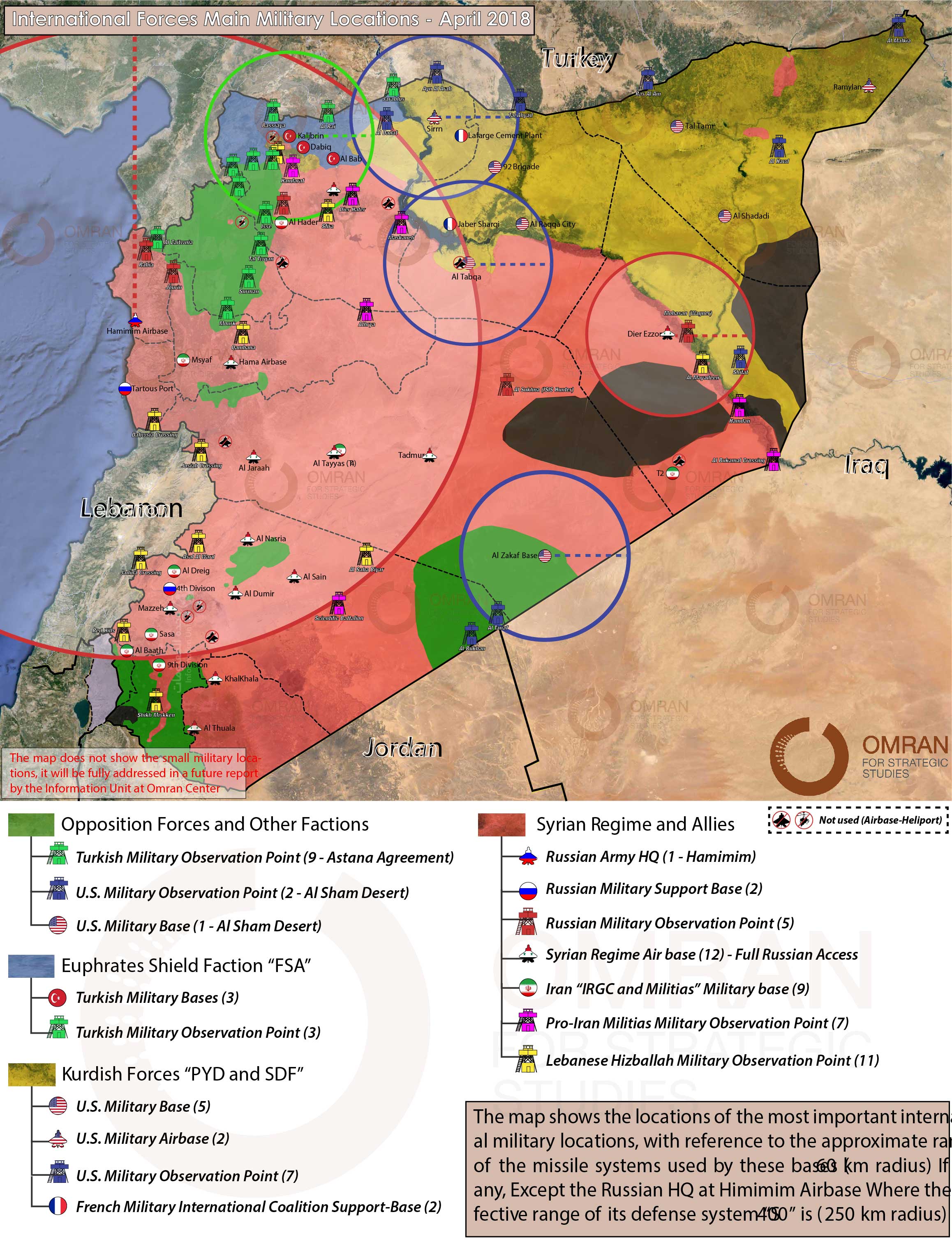International Main Military Bases and Airports- April 2018
Future of peace and stability in Syria
Omran for Strategic Studies led a panel discussion in Washington, DC on 20 March 2018. The panel in partnership with the American Relief Coalition for Syria, brought together experts from inspiring Syrian humanitarian and research organizations to discuss the current situation in Syria and prospects for a future of peace and stability. Thank you to Karam Foundation, Syrian American Medical Society- SAMS, and Oxfam America for your participation.
US in a Post-ISIS Iraq and Syria:Realigning Allies and Constraining Adversaries
On March 26, Hudson Institute hosted a panel to explore U.S. options to realign our allies with traditional NATO and U.S. positions, hold adversaries responsible for atrocities, and prevent security backsliding in the region.
The panel consisted of Hudson Institute Senior Fellow Hillel Fradkin; Hudson Adjunct Fellow Michael Pregent; Senior Intelligence Planner at the Institute for the Study of War Jennifer Cafarella; Co-Founder and Executive Director of the Omran Center for Strategic Studies Ammar Kahf; and President of Soran University Dr. Nahro Zagros.
Syrian Refugee Employment in Turkey
According to official statistics, the Turkish Republic hosts nearly 3.5 million Syrian refugees, more than any other country. A number of studies show that a vast majority of these refugees will remain in Turkey permanently, even if the situation in Syria becomes stable and return becomes a possibility. Despite this trend, however, government institutions and organizations have failed to establish a sustainable framework for integrating Syrian refugees into Turkish society. Although the Turkish government addresses some specific areas of need, many refugees must take responsibility for securing their own livelihoods. Due to a gradual decrease in international aid and the long-term presence of Syrians in Turkey, it has become more difficult for refugees to find suitable employment opportunities. Whereas issues of housing, education, health, and food are related to problems of capacity and bureaucracy, the issue of livelihoods is more closely linked to the legal framework and the perception of Syrian refugee employment among Turkish citizens. This problem is not only a humanitarian issue but a political one, both nationally and globally.
For Syrian refugees, employment is more than a job. It has a significant and sustainable impact on an individual’s life, future, and ability to integrate into a new society. Unemployment, however, is a significant problem in Turkey. Some estimates indicate that working-age people in Turkey account for more than 50 percent of the population, yet the unemployment rate exceeds 17 percent, according to the Livelihood Observatory. Moreover, in response to the influx of Syrian refugees in Turkey, an insufficient amount of funds has been allocated to livelihoods sector to enable Syrians to build their livelihoods in Turkey. According to the 2016-2017 plan of Syria's humanitarian response, the amount of funding available for the livelihoods sector was $11 million (USD), but the funding requirement was $92 million (USD). As a result, the Turkish government has faced significant challenges, creating employment opportunities for Syrian refugees, integrating and organizing refugees in the labor market, and addressing problems between refugees and their employers.
There are a number of obstacles that prevent Syrian refugees from developing their livelihoods. Most notably, legal procedures related to the employment of Syrian refugees lack clarity and integrity. In addition, there is poor communication between Syrian civil society organizations and the Turkish government, as well as a lack of representative bodies demanding employment rights for refugees.
Most Syrians live in Turkey under temporary protected status, which fails to ensure certain protections. In fact, Turkish labor laws that apply to Syrian refugees are inadequate and inefficient. Due to difficult financial conditions, refugees are vulnerable to exploitation, including unfair compensation. In addition, refugees performing physical labor at work face a higher risk of injury, yet some employers do not provide them with health or social insurance.
To overcome existing obstacles, all actors in the livelihoods sector should collaborate to create appropriate mechanisms that enable Syrian refugees to secure jobs and develop their livelihoods. Specifically, the Turkish government should create a database, accessible to all relevant parties, for Syrian employment opportunities and establish appropriate mechanisms to assess the qualifications of Syrian refugees. In addition, the government should implement vocational training programs for secured employment and establish a union for Syrian workers under the supervision of the Turkish Workers Syndicate. The government also should support Syrian refugee recruitment agencies and provide them with necessary funding and facilities. To support small business and micro-enterprisesfor Syrian refugees, government agencies should provide appropriate facilities. They also should facilitate banking and investment procedures for Syrians to expand their ventures and create new jobs, and they should utilize the financial resources and expertise of Syrians abroad in order to develop Syrian livelihoods in Turkey. In addition, the government should establish joint large-scale industrial projects connecting Syrian and Turkish investors.
Nongovernmental organizations (NGOs) should identify and develop mechanisms to sustain livelihood programs and ensure their growth. They should establish a cooperative fund to provide small grants to entrepreneurs, and they should conduct community awareness and education campaigns to inform Syrian refugees about their rights and responsibilities in the labor market. In addition, NGOs should establish programs to help at-risk refugees find employment opportunities. They also should create sustainable initiatives that enable coordination and cooperation between Syrian and Turkish employers. These programs should produce joint economic projects in all sectors and support vocational training and rehabilitation programs for Syrian refugees. In addition, these programs should ensure that Syrian refugees are not exploited due to legal status or physical condition.
With the significant and lasting presence of Syrian refugees in Turkey, temporary solutions are no longer viable, especially as more and more refugees enter the labor market. Unless concerned parties in the Turkish government work to develop sustainable solutions, refugees and their host communities will face serious problems, such as increased tension between refugees and the local population, as well as social and economic instability. On the other hand, the employment of refugees will benefit the Turkish workforce and economy, while ensuring a promising future for Syrians in Turkey.
Workshop in Geneva:"Strategies for State Building in Syria"
Omran for Strategic Studies and Geneva Centre for Security Policy (GCSP) hosted in Geneva a workshop entitled ‘Strategies for State Building in Syria,’ for a focus on centralisation and decentralisation formulas that fit post-war Syria. The workshop is part of the Syria and Global Security Project, jointly run by the GCSP and Omran. The project aims to offer a platform for collective informed discussions on Syria that could build bridges between experts and researchers in order to bring peace and security to Syria and the region.
The workshop brought together 21 experts and researchers from Germany, Norway, Russia, Syria, Switzerland, Turkey, and the United States. The participants gathered for two days on 1-2 February, 2018 to exchange views on potential trajectories of state building in Syria. The workshop discussed the geo-strategic context for political reform, as well as, political, administrative, financial and security aspects of centralisation and decentralisation.
For more details, a report on the workshop is planned to be published soon on this website.
Meeting entitled “Local Councils and Security Sector Reform in Syria”
The representatives of various public institutions and diplomats serving in the Embassies in Ankara attended the meeting as well as OMRAN and ORSAM representatives. Two reports prepared by OMRAN Center experts with respect to the local councils and security sector in Syria were presented at the meeting.
Territorial Control Map - Qunitra - 21 Dec. 2017
Iran has continued its attempts to expand in southern Syria despite international agreements aimed at curbing its role in the area. Russian and American the influential countries in southern Syria consider the arrival of Iranian militias to the Jordanian-Syrian border and the border of the Israeli-occupied Golan Heights to be “a red line,” which has necessitated direct interventions. Despite this, Iran has continued its expansion as part of the encirclement, which it has pursued in recent months.
Quneitra Front and Western Ghouta Battle Timeline (November – December)
- November 3, Regime Forces and Hezbollah repelled a large attack of HTS, in "Hadr" city in the northern side of the Golan Heights.
- 17 November, Israeli tank attacks Hezbollah “Qars Nafal” position between "Hadr" & "Ain Teenah" position, in the western side of Quneitra.
- 23 November, Hezbollah takes control of South "Beit Tima" after taking control of "Halef shor" and "Tell Al Teen."
- 30 November, Hezbollah and Regime forces established full control over the strategic hills of "Taloul Barda’yah" near the occupied Golan Heights.
- 10 December, Hezbollah and Regime forces have secured their recent gains in the Beit Jinn pocket in southern Syria.
- 13 December, According to pro-regime Medias, Regime forces, and allies will continue their operations in the area until they liberate the entire pocket or local militants accept a withdrawal agreement to Idlib.
- 17 December, Members (HTS) have reportedly started withdrawing from the village of "Maghr Al Meer" to the town of "Beit Jinn" in southern Syria.
- 19 December, According to pro-regime sources, Regime Forces, and Allies reached the eastern entrance to the village of "Maghar Al Meer." However, they were not able to enter the village because they failed to capture the nearby height – Tal Marwan (Marwan Hill).
Brigade 313 "IRGC New Military Formation"
In November 2017, Daraa province has witnessed surprising competition between Iran and Regime forces around the conscription of Syrian young men from the province, as well as the formation of a new force, Brigade 313, which is under the authority of the Iranian Revolutionary Guard.
Despite the Iranian-led brigade only being around for a number of months, it has attracted more than 200 young men; members who were conscripted for the formation were young men from Daraa who were known to work on behalf of the regime, who were currently promoting the force based on its benefits, and the salary, which its members received.
Enlistment takes place at the Brigade 313 headquarters in the city of Sa'Sa', and new members receive an ID, which has the logo of the Revolutionary Guard, ensuring his ability to pass through Regime forces checkpoints.
Why Reports of ISIS’ Demise Have Been Greatly Exaggerated
During the same week the U.S. and Russia declared victory over ISIS in Syria, the militant group launched a series of surprise attacks around the country. Despite the triumphant claims of world leaders, these offensives suggest such statements are a little premature.
The same day that President Vladimir Putin declared victory over the so-called Islamic State, the militant group launched a surprise offensive against government forces in Deir Ezzor province, killing up to 31 pro-government fighters in the following three days.
“In just over two years, Russia’s armed forces and the Syrian army have defeated the most battle-hardened group of international terrorists,” Putin told Russian forces on Monday during a visit to Russia’s Hmeimim air base in Syria, before ISIS attacked government positions north of the town of Boukamal, a former key stronghold for the militants.
U.S. President Donald Trump made similar victory claims on Tuesday while signing the National Defense Authorization Act into law. The bill, he said, “authorizes funding for our continued campaign to obliterate ISIS. We’ve won in Syria … but they [ISIS] spread to other areas and we’re getting them as fast as they spread.”
The following day, however, ISIS militants engaged in clashes with a Pentagon-backed rebel group near a U.S. base in al-Tanf in southwest Syria. Militants near the Palestinian Yarmouk camp south of Damascus also launched an attack on government positions in the nearby al-Tadamon neighborhood, seizing 12 buildings. The Syrian Observatory for Human Rights described it as the largest offensive south of the capital “in months.”
 A map of control showing territory held by ISIS south of the Syrian capital, Damascus.
A map of control showing territory held by ISIS south of the Syrian capital, Damascus.
By Omran for strategic studies -Nawar Oliver
While it’s unclear if ISIS timed the attacks as a response to the U.S. and Russian statements, the militant’s new offensives serve as a reminder that it may be too soon to sound the death knell for ISIS in Syria, experts said.
At the height of its power in 2015, ISIS commanded territory in Iraq and Syria larger than the size of Ireland. This year, however, separate Russian and U.S. military campaigns pushed militants out of all their major strongholds across the two countries. While Putin and Trump call this a complete defeat others remain skeptical.
“I think that there’s a bit of ambiguity and confusion with regard to what a defeat might look like,” Simon Mabon, a lecturer in international relations at Lancaster University and co-author of The Origins of ISIS, told Syria Deeply.
“Whilst some will talk of a military defeat and the liberation of Syrian-Iraqi territory, the bigger and arguably much trickier struggle is about defeating the ideology and preventing the group – or a manifestation of it – from re-emerging,” Mabon said.
Earlier this month, Sergei Rudskoi, a senior Russian military officer claimedthat “not a single village or district in Syria under the control of ISIL.”
According to the SOHR, ISIS still controls 3 percent of Syrian territory, or 5,600 square kilometers (2,162 square miles). ISIS is present in southern Damascus, in “large parts” of the Yarmouk camp as well as in parts of the al-Tadamon and al-Hajar al-Aswad neighborhoods, where they are battling government forces.
ISIS is also active in desert regions east of the government-held town of Sukhana in Homs province as well as in a small enclave in northeast Hama, where it is engaged in fighting with the Hay’at Tahrir al-Sham alliance.

A map of control showing territory held by ISIS in Hama province.
By Omran for strategic studies -Nawar Oliver
Militants also control at least 18 towns and villages in Deir Ezzor province, where it is battling both the Syrian government and the U.S. backed Syrian Democratic Forces. In Syria’s southern province of Daraa, ISIS controls a small enclave close to the Israeli-occupied Golan Heights, where it has previously clashed with rebel forces.

A map of control showing territory held by ISIS in the southern province of Daraa.
By Omran for strategic studies -Nawar Oliver
Some White House staff and French President Emmanuel Macron said they were wary of Russia’s claim of victory on the ground. “We think the Russian declarations of ISIS’ defeat are premature,” an unidentified White House National Security Council spokeswoman told Reutersin a report published Tuesday.
“We have repeatedly seen in recent history that a premature declaration of victory was followed by a failure to consolidate military gains, stabilize the situation, and create the conditions that prevent terrorists from reemerging,” she said.
The militant’s last vestiges of territory are coming under severe strain by a wide array of rivals. It is only a matter of time before militants are driven to rugged hideouts in Homs and in the Euphrates Valley region. But as military battles subside across the country, a slow-grinding and methodical campaign should kick off to prevent an ISIS resurgence.
“To properly talk of a victory over the group, the conditions that gave rise to them must be eradicated. By that, I mean that people must improve their living conditions, be granted better access to political structures and to be able to exert their agency in whatever way they wish,” Mabon said.
“To fully defeat ISIS, such conditions must be addressed, preventing grievances from emerging that force people to turn to groups such as ISIS as a means of survival,” he added.
However, with military operations against militants still underway, there has yet to be any significant attempt to battle the ideological residues of the group or address the grievances that led to its emergence.
In an attempt at countering ISIS’ ideology, activists and Islamic scholars set up the Syrian Counter Extremism Center (SCEC)in the countryside of Aleppo in October. However, the so-called terrorist rehabilitation center has limited funding, giving it little ability to prevent the return of ISIS, especially after hundreds of ISIS-affiliated militants and defectors flocked to opposition-held areas in northern Syria in recent months.
Iraq, whose military also declared victory over ISIS this month after driving militants from their major strongholds, is already confronting a possible return of the extremist organization, in a further indication that claims of victory are premature.
According to the Iraq Oil Report, a new armed group, hoisting a white flag that bears a lion’s head, has recently appeared in disputed territories in northern Iraq. Citing local leaders and Iraqi intelligence, the report claimed that some members of the new group are known to have been members of ISIS. This has given rise to fears that ISIS may be “regrouping and rebranding for guerrilla warfare,” the report said.
A regrouping of ISIS would not come as a surprise, especially since militants can still capitalize on grievances in marginalized Sunni communities across Iraq and Syria.
“Across both states, Sunnis had been persecuted and marginalized, politically and economically, along with the physical threat to their very survival,” Mabon said.
“Whilst many are fearful and angry of ISIS, the deeper issues of marginalization and persecution remain.”
Russia’s Brittle Strategic Pillars in Syria
With unreliable allies and a lack of experience with local power dynamics, Russia’s influence in Syria is built on fragile foundations
With political control fragmented among local powerbrokers in Syria, Russia’s overreliance on the Assad regime to protect its interests is a strategic threat. Despite current intersecting interests, neither the regime nor its Iranian allies are reliable partners. Competing and conflicting interests may finally come to a head once a political solution begins to take shape and Syria embarks on reconstruction, particularly in light of new regional arrangements.
Belying Vladimir Putin’s claim during his surprise visit to Syria that Russia is pulling back, these factors have in fact driven Russia to work to develop new tools that will enable it to maximize its gains and safeguard its interests in Syria.
Russian strengths and weaknesses
Russia reportedly has seven military bases housing approximately 6,000 individuals in Syria, and an estimated 1,000 Russian military police spread throughout the de-escalation zones and areas recently reclaimed from the opposition as a result of reconciliation agreements. Russia has also entrusted several private security forces with the task of carrying out special missions ostensibly in its war against ISIS and with protecting Russian energy installations and investment projects; these include the paramilitary group, ChVK Vagner, which, according to sources, has around 2,500 individuals on the ground in Syria.
But Russia realizes that it is not strong enough to guarantee its interests in Syria on its own and that it must rely on local partners to do so. Hence, Moscow is making efforts on two separate fronts. One is vertical – aiming to establish lasting influence within state institutions, particularly the military and security apparatus – by investing in influential decision makers, such as General Ali Mamlouk, director of the Baath Party’s National Security Bureau, and General Deeb Zeitoun, head of Syria’s General Intelligence Directorate, two of the most prominent security men.
The other is horizontal in nature. Russia is keen to develop relationships with local powerbrokers directly in order to build inroads with local communities with a view to balancing Iran’s growing influence within Syrian society. These relationships could be used as leverage to sway political negotiations towards Russian interests, while also recruiting them as local partners and guarantors for Russian investments.
Reaching out
The Russian Reconciliation Centre for Syria at Hmeimim Airbase plays a key role in communications with local powerbrokers; however, the communication mechanism and those responsible for it vary according to who controls the relevant areas. In coordination with the National Security Bureau, Russia has been able to engage with local powerbrokers in regime-controlled areas, including various political parties, local dignitaries and religious and tribal leaders, through Reconciliation Centre staff. It has also been able to communicate with the Kurds via military and security channels like Hmeimim Airbase and the Russian Ministry of Defence or via political channels managed by the Russian Ministry of Foreign Affairs in coordination with Hmeimim.
But Russia faces a dilemma communicating with local powerbrokers in opposition controlled areas and dealing with the influence of multiple regional actors. To overcome those challenges, it has employed several mechanisms to communicate with these groups in an attempt to co-opt them, using important political figures such as Ahmad Jarba to communicate with local leadership in besieged areas like Homs and Eastern Ghouta, and resorting to local reconciliation committees (primarily made up of local dignitaries and technocrats associated with the regime) that possess their own communication channels that can be used to communicate with the local opposition, as was the case in Al-Tel shortly before the Free Syrian Army’s withdrawal.
According to an activist from northern Homs, Russia is also very much dependent on cadres of Chechen Muslim military police, fluent in Arabic, to communicate with local leaderships. In addition, Moscow has used Track II diplomacy to network with local powerbrokers and open up back channels through relationships with regional powers.
Russia has so far employed the ‘carrot and stick’ model when communicating with local powerbrokers to ensure its influence, offering up benefits like security protection and financing, while guaranteeing them a place at the negotiating table and a share of reconstruction revenue. But based on past form, more heavy-handed measures to pressure local powerbrokers, such as making them targets of future military operations or playing on local rivals to marginalize or giving preference to one group over another in a political solution and reconstruction arrangements, remain on the table.
Enduring challenges
Although it has made strides stabilizing its military presence and legitimizing its security arm in Syria, Russia still faces challenges generating leverage within state institutions and Syrian society where Iran opposes Russia's efforts. The regime’s many centres of power, reliance on militias and weak institutions limit Russia’s efforts to consolidate its influence in the rest of Syria. Similarly, Moscow is finding it difficult to communicate with Syria’s many powerbrokers and differentiate between their demands, references and allegiances to other regional powers – making Russia’s strategic pillars in Syria all the more fragile.
Workshop on Cooperation Prospects in Institutional Reform and Restoring Stability in Syria
Omran Center for Strategic Studies organized a workshop in partnership with and hosted by the Geneva Centre for Security Policy (GCSP). The workshop discussed international cooperation prospects on institutional reforms necessary to restore stability in Syria. This workshop took place at GCSP on 21-22 September 2017.
The workshop brought together 35 experts and researchers from the US, Russia, Germany, the UK, France, Australia, Switzerland, and Syria. The participants gathered for two days to exchange views on stability in post-war Syria.
The vibrant discussions focused on the place of Syria in the West-Russia global power contest; institutional reforms within the political transition; prospects of cooperation on reconstruction; local governance; de-radicalization and counter-terrorism; and disarmament, demobilization and reintegration (DDR).
The workshop is part of the Syria and Global Security project, jointly run by Omran and GCSP. It is an initiative to offer a platform for collective informed discussions on Syria that eventually could build bridges between experts and researchers in order to bring peace and security to Syria, and the region.

